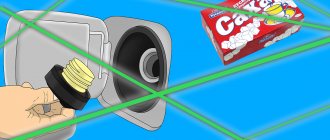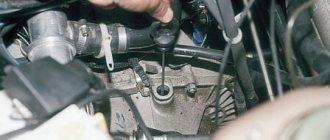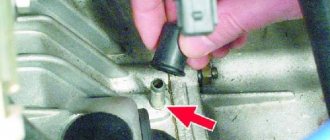As you know, hydromechanical automatic transmissions and variators are units that use not just transmission oil, but a special fluid. This automatic transmission fluid (ATF) differs in properties from analogues for most manual transmissions and robotic gearboxes.
It is also important to understand that automatic transmissions and CVTs are extremely sensitive to the level and quality of oil in the transmission. It is not difficult to guess that a decrease in level means oil starvation, which can lead to malfunctions and serious damage to the automatic transmission.
At the same time, many car enthusiasts mistakenly believe that if a low ATF level is dangerous for the gearbox, then it is better to fill the automatic transmission with as much lubricant as possible. Let us note right away that this is not true. Next, we will talk about what a high oil level in an automatic transmission can lead to, the consequences for the unit, as well as how to understand that the oil level is high and how to bring it back to normal.
Checking the oil level in the automatic transmission
To avoid overfilling the lubricant into the machine, it is necessary to check the level after filling. When checking, remember that there are two types of automatic transmission:
- with probe;
- without dipstick.
Checking the oil level in an automatic transmission without a dipstick is a little more difficult. There are types of automatic transmissions in which it is necessary to heat the oil to 70 degrees, while in others it is impossible to heat the automatic transmission more than 30 degrees. It's better to perform a level check than suffer the consequences later.
Attention! Before checking, be sure to read the automatic transmission operating instructions. The book says which gearbox is installed, to what temperature the machine should be heated, and what original oil is used for filling.
Box with probe
Checking in the box with the automatic transmission dipstick is carried out as follows:
- Warm up the car and the automatic transmission to 70 degrees or 30. Read the operating book.
- If necessary, then drive the car, switch the selector lever in all positions. This will cause the fluid to become less viscous and get into all automatic transmission components.
- Place the machine on a level surface.
- Open the hood and unscrew the plug with the dipstick.
- Wipe the probe tip with a lint-free cloth.
- Stick it back in, hold it in for a while and pull it out.
- Look at the location of the grease.
- If it is above the level with o, then it is necessary to drain the lubricant to the level through the drain hole in the pan.
- Drive the car and also check the oil level. This will prevent overflow a second time.
On a machine without a dipstick, the check is carried out differently.
Box without dipstick
Steps to check the oil level on an automatic transmission without a dipstick:
- Warm up the car, just as I described in the paragraph for an automatic transmission with a dipstick. Do not forget that among probeless boxes there are most often automatic machines that need to be heated to a temperature of 30 degrees and no more. Read relevant literature.
- Place the machine on a level surface. Do not turn off the engine.
- Get under the car and unscrew the control plug. Place a container for drainage. Wear gloves when working to avoid getting burned or getting your hands dirty.
- If oil drips, then the level is fine.
- If lubricant flows out in a stream, then either you have overheated the automatic transmission or have exceeded the lubricant fill level.
- Drive the car and check the lubricant level again.
Remember that overfilling is just as dangerous as underfilling. I will describe below what overflow can lead to.
How much lubrication is required
For automatic transmissions, or simply automatic transmissions, a special transmission fluid is provided. It has a special marking, and the easiest way to recognize it is by the ATF inscription on the packaging.
To find out exactly how much oil should be in the box, you should look at the instruction manual.
The manufacturer sets individual standards for the oil level in each type of automatic transmission.
The required amount of fresh fluid also largely depends on what replacement method is used. For example, during a partial replacement, not the full volume of the automatic transmission crankcase is drained. If the box is designed for 6 liters, and the replacement is carried out using a partial method, filling all 6 liters is pointless. Usually, when updating, you can drain about 3 liters.
When replacing yourself, it is recommended to always fill in the same amount of ATF lubricant that was previously drained. Therefore, when updating the lubricant, it is worth taking a measuring container, determining the amount of oil in it, and pouring exactly the same amount back into the box.
How much lubricant should be poured into the automatic transmission?
You should not check what will happen if you pour oil into the automatic transmission. This can lead to irreversible consequences, and therefore to major repairs. Information about the exact volume of lubricant that needs to be poured into the desired vehicle is specified in the instructions for the vehicle. Much depends on the structural features of the transport and on the method of replacing the fluid.
On average, an automatic transmission uses up to 6-8 liters of lubricant, and as a top-up, it will be enough to use up to 3 liters. When performing a partial replacement, it is not necessary to drain the old lubricant in full. It is enough to add liquid and make sure that the level meets the standards.
What is the danger of overfilling oil in a manual transmission?
Each car owner makes the decision on the need to change the transmission oil in a manual transmission based on various reasons:
- during operation, extraneous sounds come out of the gearbox;
- long mileage of the car, during which the oil was never changed;
- When buying a used car, replacing the lubricant is mandatory, since it is not known that the former owner filled the gearbox.
The design of a manual transmission is much simpler than an automatic one, and the oil in it acts as a working fluid, which significantly reduces the sensitivity of parts to quality. Accordingly, with the timing of oil changes, everything is much simpler. As a rule, in cars equipped with manual transmission, it is replaced once every 90-100 thousand kilometers.
The goals of changing oil in a manual transmission are the same as when carrying out a similar procedure in an engine - to significantly reduce wear of parts, thereby extending the life of the vehicle. The parts of this mechanism constantly collide with each other, which leads to partial abrasion of the surfaces. Thanks to the lubricant, a thin oil film is formed between them, effectively protecting not only from wear, but also from the formation of scuffing.
A manual transmission, compared to an automatic transmission, experiences a greater load. This occurs due to the impact of human physical force on the switch lever. What happens if you pour oil into a manual transmission?
Slight overflow
Some drivers measure the oil level in the box. Often it exceeds the mark by 1-2 cm. What happens if you pour oil into the automatic transmission by the specified value? Nothing serious. Such excess lubricant can be neglected, since it will not cause big problems and will not affect the operation of the box in any way. However, experts recommend listening and paying attention to the operation of the transmission when driving at high speed, even if there is even a slight overflow. Most likely, the driver will not hear anything alarming, but you still need to listen.
Symptoms of oil overflow in manual transmission
- The oil begins to foam heavily.
- The pressure in the system increases.
- Damage occurs to oil seals and rubber seals.
- Lubricant may escape through the dipstick hole.
To avoid oil overflow, do not fill the box with the entire volume of oil recommended by the manufacturer. You should fill most of it into the car 10 minutes earlier so that the liquid completely drains down, and then check the level again. If necessary, add fluid to the maximum level.
Checking the gearbox oil, as well as replacing it if necessary, are important procedures. You should carefully and responsibly approach not only the processes of checking and changing the oil in the gearbox, but also the selection of oil. The quality of work and service life of the gearbox depend on this choice, which will save money that, in the event of a breakdown due to untimely maintenance, will have to be spent on its repair.
Big overflow
Some drivers or even mechanics at service stations manage to pour liquid right under the cap. This is often done when the lubricant level in the gearbox decreases over time. But this cannot be done, because when the moving parts of the transmission operate, the oil is churned, resulting in the formation of foam and the so-called airing of the lubricant. The oil volume increases, its density decreases, and the pressure decreases. This has a bad effect on the operation of the mechanism.
Foaming is carried out more intensely at high rotation speeds, therefore, in the first case, it was recommended to monitor the atypical noise of the box. If a driver overfills the automatic transmission with oil, what consequences may follow? At a minimum, we can identify 5 characteristic symptoms that do not appear immediately, but over time.
Reasons for exceeding the oil level in an automatic transmission?
Overflow of lubricant into automatic transmissions in the vast majority of cases is caused by non-compliance with the rules when replacing the substance. The fact is that the liquid must first be allowed to drain as much as possible, and only then the required volume must be added. If this rule is not taken into account, then an excess of the norm will be obvious.
It is recommended to pour new lubricant very carefully and gradually. The substance penetrates and is distributed through the channels, which is why you need to pour it in, and then wait until the composition is evenly distributed in the system.
Another reason for this violation is that the oil increases in volume as it expands. Many drivers forget about this fact, resulting in overflow.
Is an increased or decreased oil level in an automatic transmission harmful?
The consequences of overflowing oil into an automatic transmission can be very different. A timely corrected problem will not affect the operation of the device, but if the process is not stopped immediately, the result will be damage to the box parts. Due to the huge influence of the fluid level on the stability of operation, it is important to understand the dangers of overfilling the oil. Significant excess of the norm is as harmful as a lack of lubricant.
What are the dangers of overfilling automatic transmission oil:
- transmission malfunctions, noise and poor gear shifting;
- first, the friction discs fail, and if the problem is ignored further, the remaining elements of the device will follow;
- an increase in fuel consumption caused by excess oil, forced out of the gearbox under pressure, reaching the air flow sensor;
- If liquid gets on the spark plugs, it can cause cylinder malfunctions.
The problem may not appear immediately, but during further operation, most often the driver does not notice signs of oil overflow, so it is important to monitor the fluid level regularly.
Consequences
The most harmless thing is the release of lubricant through the breather. Excess oil will simply be squeezed out by pressure through the seals, dipstick or breather. A small puddle of oil may appear under the car, and the entire transmission will also be covered in oil. This is a simple situation that does not entail serious consequences and is quite easily resolved.
If oil is poured into the automatic transmission, the symptoms may be more serious. The automatic transmission may begin to become “dull”, the car’s acceleration dynamics will disappear, and all this will be accompanied by a flashing Check Engine light. In this case, you need to read the error code, decipher it and contact the service station for help. It is quite possible that this problem can be solved by simply draining the used lubricant. But sometimes the box has to be repaired at a service station, which entails spending money on repairs.
Good and bad qualities
Despite the fact that automatic transmissions are gaining more and more adherents, there are still many drivers who fundamentally do not accept these units. And with good reason. Why do women love automatic transmissions so much?
- This unit takes on most of the functions of driving a car, making it simpler and more comfortable. There is no need to monitor the engine speed in order to change gear on time and, most importantly, correctly. There is no need to constantly depress the clutch. In short, step on the gas and have fun. That's why the weaker sex, as well as novice drivers, love automatics so much.
- The automatic transmission smoothly and gently transmits torque to the wheels without forcing the engine. This will increase its service life, increase the comfort and smoothness of the ride.
- In a big city, where there are many traffic lights, traffic jams and you have to stop often, an automatic transmission will make life much easier for the driver.
Unfortunately, this is where all the advantages of this unit are exhausted. Convenience, it turns out, comes with many rather significant disadvantages.
- The automatic transmission does not transmit all the torque from the engine to the wheels. Due to the operating principle of the torque converter, the car loses approximately 10% of its power. This immediately affects the acceleration dynamics - it is lower than that of its analogue with a manual transmission. Fuel consumption also increases (by 10–15%), which is also significant.
- Since the oil transmitting torque in the torque converter heats up, the automation requires a cooling system.
- A car with an automatic transmission costs more than one with a manual transmission.
- The reliability of automatic units is lower than that of manual transmissions - this is due to a more complex design.
- If the box fails, repairs are expensive and you won’t be able to do it yourself. To do this, you will have to attract experienced specialists.
- Automatic transmissions require regular maintenance and periodic oil changes.
- If the battery is discharged, you will not be able to start the car. It also cannot be towed, nor can it be engine braked.
- The most important thing is that classic automation does not allow the driver to fully control his car, making it difficult to maneuver in emergency situations. The consequences can be tragic, especially in icy conditions and off-road conditions.
Troubleshooting
All experts recommend checking the transmission oil level. If overflow occurs, then it is easy to solve the problem even without contacting a service station. To do this you need:
- Buy a 10 cc syringe and a dropper at the pharmacy.
- Cut a piece 60 centimeters long from the tube.
- Insert it into the dipstick hole. If there is no such hole, then the tube can be inserted into the neck to fill the lubricant.
- Now we put the second end on the syringe without a needle.
- Use the plunger of the syringe to suck out excess oil from the box.
There is no need to remove a lot of lubricant at once; you need to act gradually. After each intake, you need to check the current oil level, because if the level is below normal, you will have to add oil back.
How to remove excess lubricant from the system?
A slight overflow is not a big deal, but when the problem may require quick intervention. You can fix the problem yourself by removing the oil filter. The liquid will completely drain from the system, after which it remains to install it in place.
If such actions do not solve the problem, you will have to remove the grease using the “suction” method. For this, a regular dropper and syringe are used. Excess liquid is removed through the dipstick hole. The manipulations are not complicated and do not require a visit to a service station.
Checking the oil level in the automatic transmission
To obtain the most accurate results, you need to check the transmission fluid level both in a warm state and in a cold state, using a dipstick. Before checking, you should pay attention to the car manufacturer's recommendations in this regard. Many devices have o and “HOT”; you need to navigate according to the scale that corresponds to the condition of the oil.
The procedure is carried out with a warm transmission or after starting the engine for 3 - 5 minutes, after which you can begin:
- We put the car in park or neutral position;
- we take out the control dipstick, wipe it dry and return it to its place;
- we take out the device again and analyze the situation;
- if there is a deficiency, add lubricant (you need to pour it slowly), and if the oil level in the automatic transmission is higher than normal, then we take measures to remove excess;
- After driving 10 - 1 km, you need to repeat the checking procedure.
How much lubrication is required
For automatic transmissions, or simply automatic transmissions, a special transmission fluid is provided. It has a special marking, and the easiest way to recognize it is by the ATF inscription on the packaging.
To find out exactly how much oil should be in the box, you should look at the instruction manual.
The manufacturer sets individual standards for the oil level in each type of automatic transmission.
The required amount of fresh fluid also largely depends on what replacement method is used. For example, during a partial replacement, not the full volume of the automatic transmission crankcase is drained. If the box is designed for 6 liters, and the replacement is carried out using a partial method, filling all 6 liters is pointless. Usually, when updating, you can drain about 3 liters.
When replacing yourself, it is recommended to always fill in the same amount of ATF lubricant that was previously drained. Therefore, when updating the lubricant, it is worth taking a measuring container, determining the amount of oil in it, and pouring exactly the same amount back into the box.
Should I change the oil in an automatic transmission: myths and reality?
You can hear from manufacturers that changing the oil on modern gearboxes is not necessary. This is a marketing ploy. It is necessary to change the automatic transmission oil and filter at certain intervals.
- partial replacement is carried out after 30,000 km;
- full shift – 60,000 km.
Attention! For CVT transmissions, it is recommended to reduce these periods.
The thing is that if you drive for a long time during testing, this will lead to a major overhaul after 150,000 kilometers or replacement of the gearbox. It all depends on the design, childhood diseases and operating conditions. In difficult operating conditions in Russia, I advise you not to pay attention to the manufacturers’ advice, but to regularly change the transmission fluid.
Replacing transmission lube
If the car owner feels strong and has the opportunity to carry out a partial oil change on his own, he should adhere to some mandatory rules. It must be remembered that this procedure is simple and at the same time time-consuming. In addition, it is unlikely that it will be possible to completely replace the lubricant - for this you need to have an assistant, special equipment and tools. Therefore, it is better to resort to the help of service station specialists.
- A car with a warm transmission is driven onto an inspection hole or overpass. The box selector switches to P or N (depending on the model). In the automatic transmission crankcase, the drain plug is unscrewed, from there 30–40% of the total oil volume is drained into the container, no more.
- The plug is screwed in, and exactly the same amount of fresh lubricant is poured through a special hole as has leaked out.
How much oil do you need to fill in an automatic transmission?
Information about the exact filling volumes of a particular box is contained in the manual, because the standards for each type of device for different cars are different, it all depends on the features of the structure. How much oil needs to be poured into the gearbox also depends on the replacement method. The average volume of the box is 6 – 8 liters; when updating the liquid, it can take about 3 liters. A partial replacement does not imply a complete oil change, so you usually fill in new transmission fluid in the same volume that was drained, and then adjust its level as necessary.
With a slight overflow, you don’t have to worry about serious consequences, and it’s unlikely that you’ll be able to notice that the level is exceeded by 1 – 1.5 cm during the operation of the box. It’s another matter if the volume of oil poured into the automatic transmission significantly exceeds the permissible norm. In this case, an unpleasant result with subsequent repair or replacement of the device will not take long to occur.
Signs of oil overflow:
- the pressure in the system increases, as a result of which liquid leaks out through the breather hole, oil seals, dipstick plug, but this is the least of the evils provoked by its excess;
- as a result of oil foaming, bubbles form, which reduce the quality characteristics of the lubricant, and the density of the composition decreases;
- The automatic transmission functions unstably, there are jerks and jolts, often accompanied by noise;
- in conditions of poor heat transfer, the likelihood of overheating of the box increases.
Any deviations from the normal functioning of the device should alert the driver, since over time the situation only gets worse and can lead to severe damage to the automatic transmission.
How to check the amount of car oil yourself?
In order to correctly fill the oil product into the gearbox without exceeding the maximum mark, it is advisable to use a dipstick. It has several special marks that allow you to set the amount of oil in the automatic transmission. “GOLD” is intended to check the volume of lubricant poured when changing it. “HOT” indicates the volume of oil when the engine is warm. You need to look exactly at this mark.
Checking the oil is carried out when the car is warm
To add oil to an automatic gearbox, you need to take into account the following nuances:
- Control of the volume of motor oil (in certain cars) is carried out after the transmission is heated to operating temperature. Let the engine idle for about ten minutes.
- Before checking, the vehicle is placed in the “P” or “N” position. It all depends on the car model and its manufacturer.
- If there is only one mark on the dipstick, you need to focus on it.
- When using certain cars, it is not necessary to check the volume of oil fluid, because its operating period is very long.
It is advisable to pour special motor oil into the automatic transmission. It is intended for:
- transmission of torque from the engine to the transmission;
- removing small particles that appear when parts come into contact;
- lubrication of spare parts.
To prevent automation malfunctions, pour into the unit only high-quality petroleum products from a reputable manufacturer, purchased at a trusted retail outlet (preferably an official one).
Device
Modern automation uses completely different operating principles than a manual transmission - it is much more complex and, accordingly, more expensive. Let's look at the main parts that are present in all automatic units.
- The hydraulic transformer is the main component, without which work is simply impossible. This is an analogue of the clutch that is used with a manual transmission, but it is more complicated. Its purpose is to transmit torque from the engine to the drive wheels using a working fluid - oil.
- The planetary gear set, or gear, distributes the incoming force from the engine to other structural elements of the gearbox, while changing the gear ratio. In a manual transmission, this is a set of gears that interact with each other when changing gears.
- Friction disc, or clutch, - with the help of this element the gears are changed. It is controlled by an electronic unit.
- Overrunning clutch is one of the components that make up the torque converter. Protects the friction clutch, as well as other parts of the automatic transmission, from sudden shocks and vibration when the gear ratio changes (gears are switched).
We will not understand the intricacies of the automatic transmission. The main thing is that it is more complex than a manual transmission. This leaves its mark on its advantages and disadvantages.










